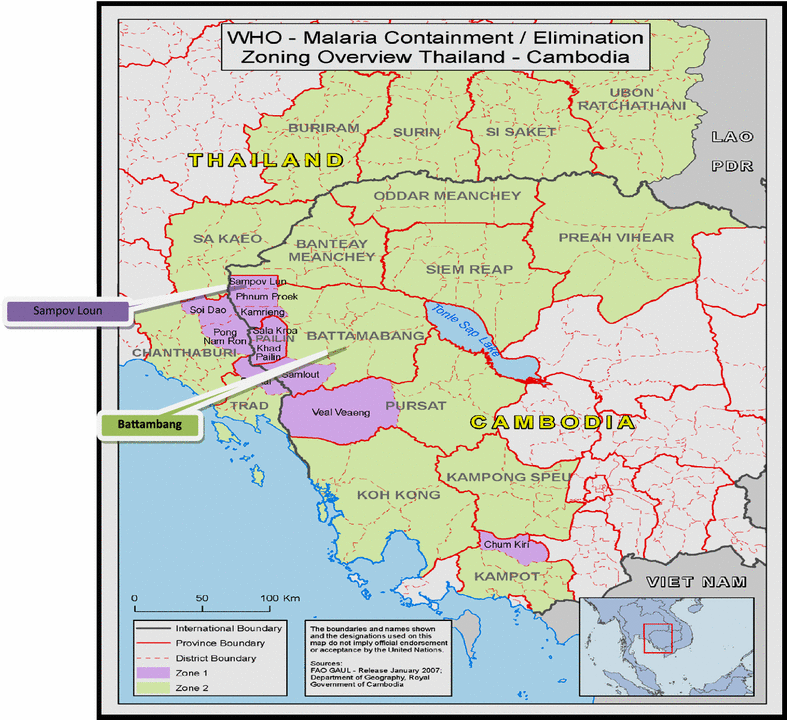Positive deviance as a novel tool in malaria control and elimination: methodology, qualitative assessment and future potential
- PMID: 26879638
- PMCID: PMC4754848
- DOI: 10.1186/s12936-016-1129-5
Positive deviance as a novel tool in malaria control and elimination: methodology, qualitative assessment and future potential
Abstract
Background: Positive deviance (PD) is an asset-based, community-driven approach to behaviour change that has successfully been applied to address many health and social problems. It is yet to have been assessed for malaria control but may represent a promising tool for malaria elimination given its suitability in targeting small and remote population groups, apparent sustainability and ability to instil a high amount of community mobilisation. Here, the PD methodology as applied to malaria is explained, with focus upon and qualitative assessment of a proof of concept study in Cambodia.
Methods: Three villages in Battambang, northwestern Cambodia were selected for the intervention, with an estimated population of 5036 including both residents and migrant workers. In August 2010, field teams conducted a 1 week PD process to sensitise and mobilise the community, establish normative behaviours in relation to malaria control and prevention, identify positive deviant behaviours from within the community, and identify PD volunteers. Until March 2011, PD volunteers were supported by field teams via monthly meetings to conduct activities in their respective communities to increase practice of PD behaviours. In February 2012, 1 year following the end of external support, evaluative interviews were conducted with community members to qualitatively assess community acceptance and interpretation of the PD intervention, perceived behaviour changes, and perceived positive outcomes.
Results: Qualitative data from focus group discussions and in-depth interviews showed that the PD approach was well-accepted into the communities and created a strong sense of community empowerment. Positive behaviour change was linked to the PD intervention, including greater usage of nets by forest goers, and use of public health facilities for malaria diagnosis and treatment. One year following the end of external assistance, PD volunteers were still conducting activities in their respective communities.
Conclusions: PD offers a promising tool in malaria control and elimination settings. Work is ongoing to quantitatively measure impact of PD on behaviours and malaria transmission and once gathered, national malaria control programmes should be encouraged to look at including PD as part of their national strategies. Feasibility of scale-up, cost-effectiveness, and applicability to other settings and diseases is also currently being explored.
Figures







Similar articles
-
Behavioural determinants of malaria risk, prevention, and care-seeking behaviours among forest-goers in Cambodia.Malar J. 2022 Dec 2;21(1):362. doi: 10.1186/s12936-022-04390-5. Malar J. 2022. PMID: 36457085 Free PMC article.
-
Forest work and its implications for malaria elimination: a qualitative study.Malar J. 2019 Nov 27;18(1):376. doi: 10.1186/s12936-019-3008-3. Malar J. 2019. PMID: 31771587 Free PMC article.
-
A prescription for sustaining community engagement in malaria elimination on Aneityum Island, Vanuatu: an application of Health Empowerment Theory.Malar J. 2015 Jul 31;14:291. doi: 10.1186/s12936-015-0779-z. Malar J. 2015. PMID: 26228787 Free PMC article.
-
How can interventions that target forest-goers be tailored to accelerate malaria elimination in the Greater Mekong Subregion? A systematic review of the qualitative literature.Malar J. 2019 Feb 1;18(1):32. doi: 10.1186/s12936-019-2666-5. Malar J. 2019. PMID: 30709399 Free PMC article.
-
Conquering the intolerable burden of malaria: what's new, what's needed: a summary.Am J Trop Med Hyg. 2004 Aug;71(2 Suppl):1-15. Am J Trop Med Hyg. 2004. PMID: 15331814 Review.
Cited by
-
Community engagement, social context and coverage of mass anti-malarial administration: Comparative findings from multi-site research in the Greater Mekong sub-Region.PLoS One. 2019 Mar 25;14(3):e0214280. doi: 10.1371/journal.pone.0214280. eCollection 2019. PLoS One. 2019. PMID: 30908523 Free PMC article. Clinical Trial.
-
Perceptions about malaria among Brazilian gold miners in an Amazonian border area: perspectives for malaria elimination strategies.Malar J. 2021 Jun 26;20(1):286. doi: 10.1186/s12936-021-03820-0. Malar J. 2021. PMID: 34174880 Free PMC article.
-
Using the role model approach to optimise caregiver administration of sulfadoxine-pyrimethamine amodiaquine to children aged 3-59 months in Burkina Faso, Chad and Togo: findings from an evaluation.Malar J. 2024 Aug 24;23(1):255. doi: 10.1186/s12936-024-05067-x. Malar J. 2024. PMID: 39180068 Free PMC article.
-
Behavioural determinants of malaria risk, prevention, and care-seeking behaviours among forest-goers in Cambodia.Malar J. 2022 Dec 2;21(1):362. doi: 10.1186/s12936-022-04390-5. Malar J. 2022. PMID: 36457085 Free PMC article.
-
Misperceptions of patients and health workers regarding malaria elimination in the Brazilian Amazon: a qualitative study.Malar J. 2019 Jul 4;18(1):223. doi: 10.1186/s12936-019-2854-3. Malar J. 2019. PMID: 31272509 Free PMC article.
References
-
- The Positive Deviance Initiative . From the inside out—local wisdom. Boston: Global Impact; 2010.
Publication types
MeSH terms
LinkOut - more resources
Full Text Sources
Other Literature Sources
Medical

